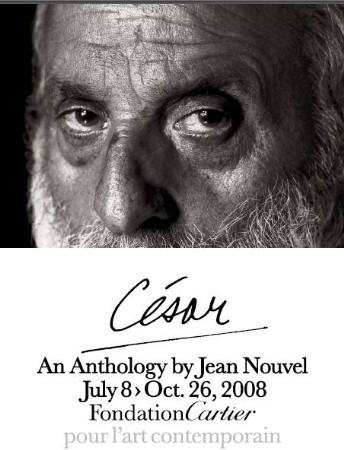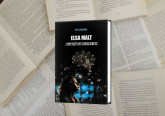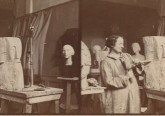Paris, July 8, Oct. 26
From July 8 to October 26, the Fondation Cartier pour l'art contemporain will be featuring a major exhibition of the work of the French sculptor César on the tenth anniversary of his death. Jean Nouvel, architect of the Fondation Cartier and a close friend of the artist, has been invited to select the works and design their presentation, thus offering a fresh perspective on the work of an artist who passionately explored the formal and expressive possibilities of industrial materials.
---------------------------------------------------------------------------------------------
 Photo Fondation Cartier
Photo Fondation CartierThrough this exhibition, the Fondation
Cartier will celebrate an artist who
played a major role in its history, from
its inception in 1984 until his death
in 1998. It will include nearly one
hundred of the most significant works
from four major groups: the Fers, the
Compressions, the Empreintes humaines,
and the Expansions. Influenced by the
examples of great artists of the past,
yet imbued with a sense of the radical
and innovative, César's work defies
conventional ways of thinking about
sculpture and has profoundly
impacted the art of today.
 Photo Fondation Cartier
Photo Fondation CartierCésar and the Fondation Cartier
César and the Fondation Cartier
César's own history is closely linked to
that of the Fondation Cartier. In the early
1980s, he played an integral part in the
creation of the Fondation by urging Alain
Dominique Perrin, President of Cartier
International at the time, to create an
alternative exhibition space that would
allow artists to develop their projects freely.
Likewise, the Fondation Cartier, which
was inaugurated in 1984 in Jouy-en-Josas
with Les Fers de César, supported César
throughout his late career with regular
presentations of his work. Also in 1984,
César began work on the Hommage à Eiffel,
a monumental sculpture in the Fondation's
park made with the steel girders that had
been dismantled from the Eiffel Tower in
an effort to lighten its structure. This work
was inaugurated in 1989, to celebrate
the centenary of the iconic monument's
construction. Organised in 1986, the
exhibition Les Championnes de César gave
- the artist an opportunity to renew his
sculptural vocabulary while revisiting the
idea of crushed cars that he had originated
in Villletaneuse in 1959 and explored
in the 1970s. In 1989, for the exhibition
Solex-nostalgie, César made a Compression
from France's much-loved moped
- (Compression Solex, 1988). In 1991 the
collaboration with Cartier gained an
international dimension when César
took part in the exhibition Too French in
Hong Kong and Tokyo. The following
year, Cartier commissioned and donated
to the city of Hong Kong a monumental
sculpture, The Flying Frenchman.
 Photo Fondation Cartier
Photo Fondation CartierJean Nouvel and César
Jean Nouvel and César
A classically trained sculptor who became
a great formal innovator, César shared
many of his thoughts about art with Jean
Nouvel during the holidays that they
spent together: “Can a work of art that
does not show evidence of craftsmanship
still be considered art?” César was torn
by an inner conflict clearly described by
Catherine Millet: “César, as classical as
his spirit may be [...], as attached as he
is to the importance of craft, has found
himself caught in a dilemma, he has
discovered that sculpture is not just an
art of accurate proportions and beautiful
materials to be touched, it may also be an
idea.” In the view of Jean Nouvel, who
in his own work has dematerialised and
conceptualised architecture, it is essential
to emphasise this conceptual aspect of
César's art by focusing on its three key
sculptural procedures, or gestures: the
Empreintes humaines (human imprints),
the Expansions and the Compressions. He
has done this by opting for a typological
rather than chronological presentation.
He also includes a number of welded
iron pieces, the Fers, the expressive and
naturalistic qualities of which remind
us of the sculptor's technical virtuosity.
Jean Nouvel's exhibition design strives to
mender intelligible a body of work replete
with contradictions, combining both
virtuosity and invention, traditional media
and contemporary materials, and classical
techniques and experimental processes.
 Photo Fondation Cartier
Photo Fondation Cartier“César3” by
Jean Nouvel
- “César3 thought transmission”
by Jean Nouvel
(excerpt from the exhibition catalog)
Ten years. Time passes.
Ten years since
you've spoken to me of your doubts, your
fears, your incomprehension at the lack
of recognition and of course your fear of
being forgotten. Memories fade. What
remains are shards of light, moments of
bedazzlement. Art bears witness long
afterwards to dated attitudes that become
landmarks. The life of an artist is marked
by what he extracted from time, from his
time, because he made us see and then
look at what we failed to identify. Don't
worry, your work went deep. I have always
been impressed by the importance you
placed on working, as if suffering and the
time of your efforts were criteria for the
authentication of the work. Your contempt
for easy, immediate and automatic
work is clear. In fact, that explains your
rejection of much of the art produced in
your day... When I think that because
of your hedonism, your kindness, your
generosity, your good humour and your
love of good food and exciting company,
some who didn't know you took you for
some kind of ham actor... but then when I
think of your stylistic divertissements and
those irrepressibly childlike games you
played with your virtuosity, well, we can't
help smiling, and maybe even begin to
understand them... But the public clown
has shuffled off the stage. Time does its
sorting.
What remains is what you mined
from the depths of your times.
- 1. Those concentrated, densified, entangled
and folded blocks of steel that express both
a mechanical past and repeatable futures
whose cycles may one day be revealed by
other artists.
- 2. Those fists, those hands, those fingers,
those breasts—samples of the human
body, emblems of sensuality enlarged to
anatomical perfection to include even the
fingerprints, the grain of the skin and the
pores, and that entomologist's surprise at
the strangeness of our human species.
The revelation and dissociation of form and
fragments by different materials, colours
and scales.
- 3. Then there is that substance that flows
and suddenly congeals in the middle of
its movement, its sliding, its swelling.
That perfect glossiness, smooth enough to
caress, which comes from nowhere and is
going nowhere yet is there, proud in the
perfection of its curves.
This is what you mined from the depths of
the twentieth century, a century that wasted
away in steel, questioned the dimensions
of man and the universe and played God
with unidentified and chemically modified
materials. They are three nuggets, or rather,
three seams that tell us and will tell us as
much about the essence and sensations of
that century as the most respectable theses,
photographs or writings in our libraries.
Doubt no more, César: not only are you
recognised, you are identified. Compressor.
Enlarger. Expander. César3 does not signify
some chemical formula or César III but
César to the power of three. Exponential,
my friend... I'll see you soon for more
thought transmission in the pitch-black but
starry night...
- 261, boulevard Raspail 75014 Paris
- Tel. +33 (0)1 42 18 56 50 ,
Fax +33 (0)1 42 18 56 52
- Métro Raspail or Denfert-Rochereau (lines 4 & 6)
- RER Denfert-Rochereau (line B)
- Bus 38, 68, 88, 91
- Vélib' 2, rue Victor Schoelcher
- Disabled parking at
2, rue Victor Schoelcher
- The exhibition is open to the public
every day except Monday from
11 a.m. to 8 p.m.
- Open Tuesday evenings until 10 p.m.
- Admission: 6.50 €
- Reduced rate*: 4.50 €
- Admission free**
- Free entry for all visitors on
Wednesday from 2 p.m. to 6 p.m.
- Ticket sales in advance at Fnac stores.
* Students, under 25, “carte Senior” holders,
“Amis des Musées,” unemployed
** “Laissez-passer,” Circle of Friends,
children under10, and ICOM members.
Par






Ajouter un commentaire